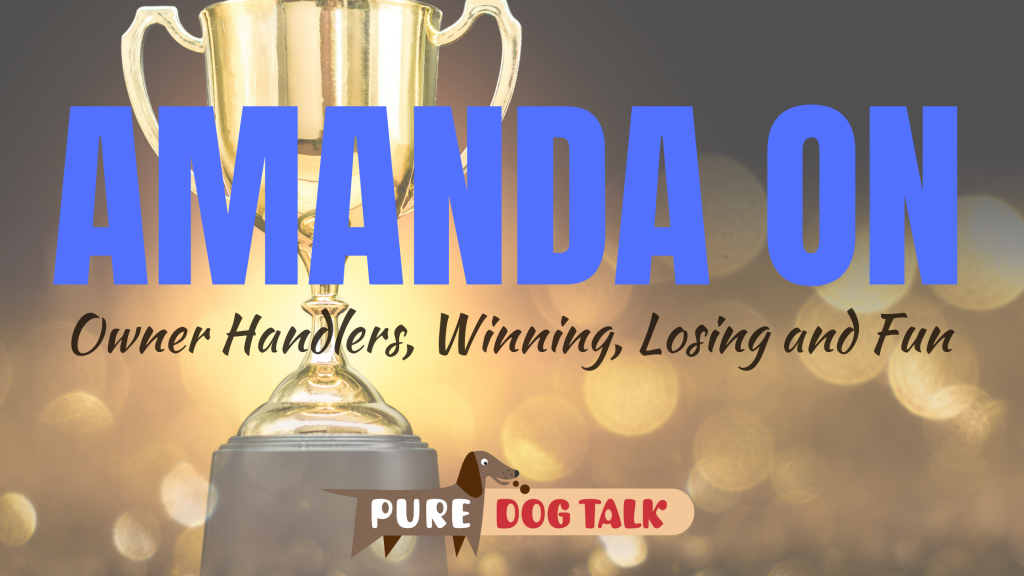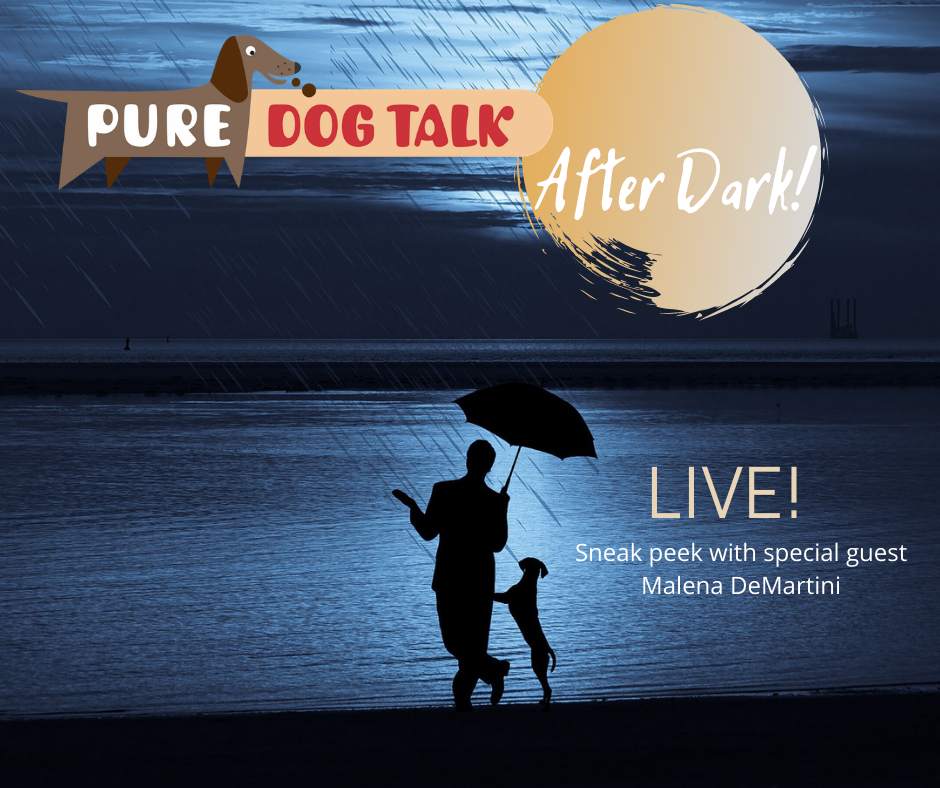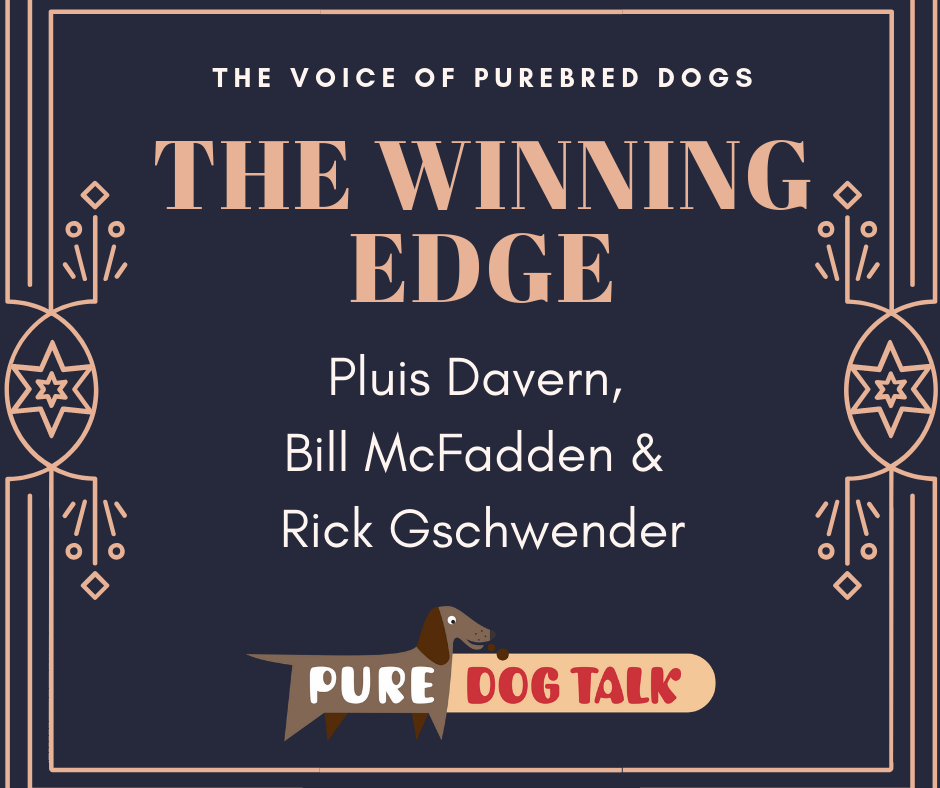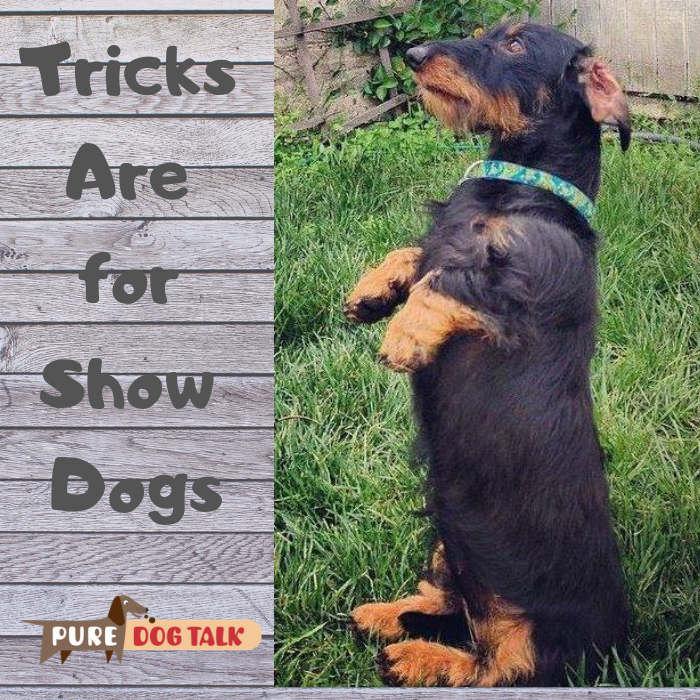495 — Amanda On… Owner Handlers, Winning, Losing and Fun
479 – Anxiety, FOMO or Frustration?
433 — Five Tips for Staying Motivated During Uncertainty
322 – The Winning Edge! Panel Discussion With the Masters
The Winning Edge! Panel Discussion With the Masters
Host Laura Reeves moderates a Friday Night Forum Panel Discussion on the topic of the “Winning Edge” with Judges Rick Gschwender and Pluis Davern and Professional Handler Bill McFadden.
It is not the judge’s job to find a “diamond in the rough,” Reeves posits. “Polish your “gem stone” for your best chance of success.”
Good habits
 Gschwender starts the discussion by asking the audience about their habits with the dogs they exhibit.
Gschwender starts the discussion by asking the audience about their habits with the dogs they exhibit.
“How many of you train your dog? Road work him? Take video to see what the judge sees? Clean their teeth?” Gschwender queried. “I see people all the time, they’re paying $30 to enter the dog and haven’t even cleaned teeth.”
Gschwender adds, “Watch the judges. If you pay attention, you will see consistency in what they put up. You might not like it, but you will figure out what I like and come back and show that to me.”
Motivated by motion
Davern noted, in a fascinating observation, that people are *predators.* Which means “we are motivated by motion. What are judges looking at?” Davern asked rhetorically. “Motion. It catches the eye. You can *subtly* move your hand to show a pretty head, for example.
“You’re in the ring, you’re all showing the same “product.” There’s 20 boxes of cornflakes. What makes yours better than the others?”
Owner handlers have a huge advantage, Davern said. They are spending time with the dog they love.
“This is a great sport! Nobody takes a golf club to bed at night,” Davern said. “Life is not all about winning.”
Be prepared
“Take a deep breath and don’t rush,” McFadden advises. He also notes that in some cases, owner handlers who are long time breeders are “experts showing to novices.” Judges are life-long learners and may be new to a breed. “Present your breed the way it should be shown.”
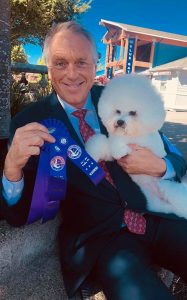 Most importantly, McFadden said, be prepared. “Make sure your dog is in condition, physically, mentally, emotionally.”
Most importantly, McFadden said, be prepared. “Make sure your dog is in condition, physically, mentally, emotionally.”
“You’ll have successes and failures you deserve and ones you don’t. It happens to handlers too. We show 20 dogs and might win with two,” McFadden added.
For more insight from a couple of these panelists, you can listen back to:
https://puredogtalk.com/10-bill-and-taffe-mcfadden-live-at-akc-nationals-wisdom-wednesday-2/
https://puredogtalk.com/34-sussex-spaniels-hunt-tests-search-and-rescue-pluis-davern-tells-all-2/
https://puredogtalk.com/35-dogs-to-the-rescue-firefighters-first-responders-and-pluis-davern-2/
321 — Tricks Are for Show Dogs! Improve Focus in the Ring
Tricks Are for Show Dogs! Improve Focus in the Ring
Show Dog Prep School founder, Vicki Ronchette, provides tips for training tricks to show dogs to help them focus and have fun.
“Training tricks is fun,” Ronchette said. “People and dogs enjoy it more than they do training traditional exercises. It is relaxing. And it’s a good way for people to improve their mechanical training skills.”
Dogs get bored in the ring, Ronchette noted. Having a repertoire of tricks available helps dogs and exhibitors relax, she said.
Bonus, the dogs and handlers having fun makes a good impression on audience and serve as crowd pleasers. Note the phenomenal success of the “sit up” by the Sussex Spaniel, Bean, at the 2018 Westminster Kennel Club show.
Ronchette shared a few of her favorite “tricks” to teach clients that provide specific benefits to dogs and their performance.
Touch!
Target training is a favorite of Ronchette’s. She trains the dog to touch its nose to her hand.
“It’s so beneficial,” Ronchette said. “It’s easy to teach. And when you have a distracted dog, it gets their attention.”
Sit Pretty
Sit up and beg can be a controversial trick, as some feel it can be harmful to the dog’s back. Other trainers argue it is indispensable core conditioning that strengthens back muscles. Either way, that super cute “begging” for attention is a sure fire winner.
Get on top
Teaching the dog to get up on a big rock, grooming table or other high perch, Ronchette says, is a great confidence builder. “They need to own these behaviors,” she noted.
AKC’s Trick Dog program allows owners to put a fun title on the end of the dog’s name, Ronchette noted, helping them “get their feet wet in something other than conformation.”
To learn more about the origins of the Trick Dog program, take a listen to my interview with AKC’s Doug Ljungren, the program’s biggest advocate.
128|Doug Ljungren is Up to Tricks…Trick Dogs|AKC VP of Sports and Performance|Pure Dog Talk
319 — Cavalettis for Show Dogs with Vicki Ronchette
Cavalettis for Show Dogs with Vicki Ronchette

Vicki Ronchette with her Lowchen.
Show Dog Prep School founder Vicki Ronchette shares her tips and tools for using cavalettis to train body awareness, conditioning and more.
Cavalettis, Ronchette said, are useful for a variety of issues. Dogs who pace, forge on the leash, need to know where to put their feet amongst other topics are well served by practicing with caveletti training.
One of the most common uses is to build muscle memory to increase reach and extension, Ronchette said. “Most dogs love doing the cavalettis,” she added.
Using simple, inexpensive materials, Ronchette provides direction for building and utilizing these obstacles in an exhibitor’s “tool kit” of preparing the dogs for the show ring.
How To’s and Why For’s
One of Ronchette’s most frequently asked questions is how far apart to set the poles for proper gaiting. She said she measures from the front toe to the back toe when the dog is in a comfortable stack. That is the “elementary” distance the poles are placed apart. As the dog gains skill and confidence, the poles are moved further apart to make them the dog increase its stride.
“We’re asking these dogs to be athletes in the show ring,” Ronchette said. “It’s more than just walking around. It’s walking around and looking fabulous.”
One specific training opportunity Ronchette uses the obstacles for is to teach not to chase other dogs. “I make them concentrate on foot work instead of chasing,” she observed.
“I strongly believe that if there is any physical limitation the dog is aware of it and it increases anxiety,” Ronchette said. “When you do these type of exercises, the dog ‘owns’ that behavior and it creates confidence. Confidence changes a dog’s carriage.”
Ronchette’s course at Show Dog Prep School.
Canine Conditioning with Dixie Rae Sick.
251 – Trainer Suzanne Clothier on Relationship Building with Your Dog
Suzanne Clothier Talks Relationship Building
Suzanne Clothier has developed a training and assessment system built entirely around relationship building with our dogs.
“Animals have been my whole life,” Clother said. “It’s a lifelong passion, that has informed a fascinating journey.”
Clothier’s seminal book, Bones Would Rain from the Sky, was published in 1998. Her warm, down to earth, compassionate nature shines through as she shares her journey and what she’s learned.
Relationship building
“If you have a trusting relationship,” Clothier said, “it’s then about what you enjoy doing together.”
Training show dogs is a skill like any other, Clothier noted. She added that not all dogs have “the Sandra Dee gene” that makes them enjoy being the center of attention.
“We’re like crazy stage moms,” Clothier said, “asking our dogs to be on stage.” For dogs who train well at home but don’t give us the performance we’re expecting at a show, “It’s like singing in the shower,” she noted, “It’s not the same as auditioning for The Voice.”
Clothier’s goal is to evaluate all interactions with a dog through the prism of “How does this affect the relationship with me and the animal.”
Tools for the job
Her training goals are to stay humane, fair, loving and respectful, Clothier said. She has developed tools for trainers to help diagnose both handlers and dogs.
Her Relationship Assessment Tool helps clarify “which end of the leash is contributing to the problem,” Clothier said. “What do I need to fix. And where’s the good stuff. What can we build on.”
She’s also created an ap, to be released this month, that enables owners, handlers and caretakers to literally track exactly how a dog is feeling on a given day. This Functional Assessment Tracking program provides feedback using the dog’s behavior, activity, food intake etc to determine, literally, “how are you today.”
For more information, visit:

